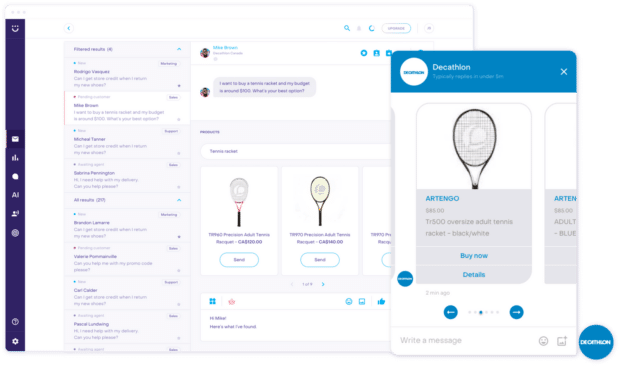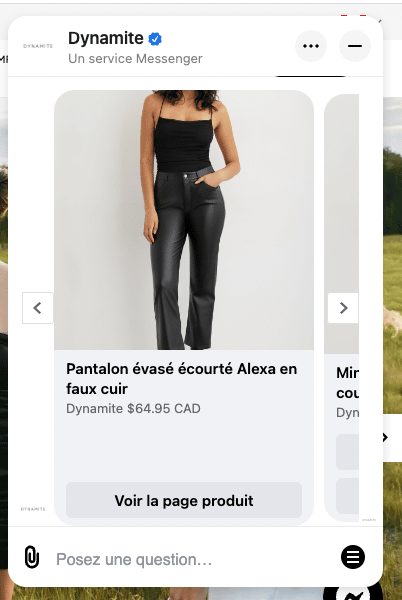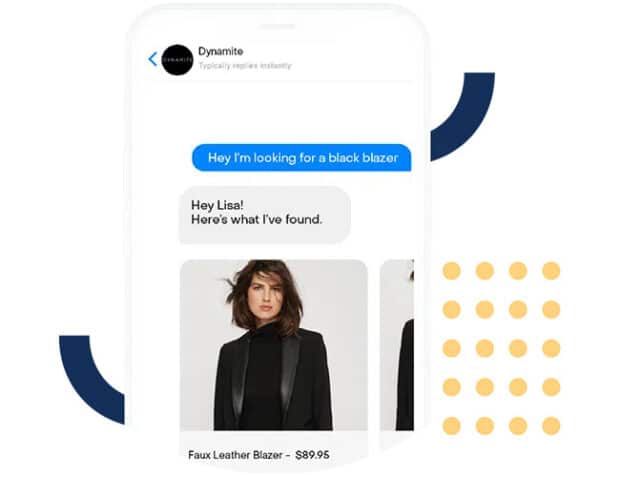The film Lost in Translation is not only a cult favorite from 2003, but it is also a very real experience that retailers want to avoid when communicating with customers at all costs. This is true of in-person interactions but it is also true online, where brands are seeing their eCommerce business grow and where customers are increasingly turning for support. Enter: the multilingual chatbot.
Merchants are now dealing with more website traffic than ever and are searching for ways to engage with and serve a greater volume of online customers better.
And that’s where multilingual chatbots come into play, helping merchants engage with customers online with personalized, contextually relevant conversations in virtually any language.
Let’s dive into why it’s important for merchants to offer personalized customer experiences online and how that can be achieved using multi-language AI chatbots.
Bonus: Get a free, in-depth guide to The Why, What, and How of Social Commerce. Learn how to sell more products on social media and delight your customers without relying on cookies.
What is a multilingual chatbot?
A multilingual chatbot provides online shoppers with live chat and automated support in multiple languages through messaging apps such as Facebook Messenger or on websites. It uses artificial intelligence to answer questions and perform simple tasks in a customer’s preferred language. For brands that operate in multiple geographies or regions with several spoken languages, multilingual chat capabilities are a must.
Brands can implement multilingual chatbots in several ways: they can create a separate chatbot for each language they support, use Google translate, or partner with an AI chatbot platform like Heyday that has built-in multilingual capabilities. Customers like Merci Handy serve customers in both French and English using Heyday’s chatbot—no translator necessary!

Rather than build a new-net chatbot for each region where you sell, using a single chatbot with multilingual capabilities is both less time-intensive to deploy and more scalable if you decide to expand into new markets. Multilingual chat is one of the foundations of an effective, scalable social commerce strategy.
How do multilingual chatbots work?
Multilingual chatbots have language detection capabilities to better serve customers. For example, if a customer engages with the chatbot in French, then the chatbot will deliver customer support in French. But if the next customer for that chatbot asks a question in English, then the chatbot will answer in English.
Building a multilingual bot will help you provide multilingual support to customers all over the world.
4 benefits of using a multilingual chatbot
There are many reasons why your team should think about using a multilingual AI chatbot, especially if you have an existing or planned international footprint.
Beyond the basic benefits of using AI-driven chat—including 24/7 customer service, centralized customer support management, and automated responses to order queries and FAQs—multilingual chat enhances the scalability of your business and improves the customer’s self-serve shopping experience and more. To make things easier, we’ve broken down the advantages of multilingual chatbots into four categories:
- Customer engagement
- Sales potential
- Customer loyalty
- Competitive edge
1. Boost customer engagement
How likely are you to engage with someone if you both don’t speak the same language?
Exactly.
The same is true between brands and potential customers.
The number one benefit of turning to multilingual live chat is that it creates a better experience for your customer and boosts engagement. By accommodating their preferred language of communication, customers can get the information they need faster, which makes for a better shopping experience.
Think about it, if your customer submits a query in French and your chatbot responds in English, it shows the customer that they have to be the one to compromise.
That’s not very customer-centric.
Remove any friction in your customer’s experience, starting by communicating on their terms and in their preferred language. It goes without saying that communicating with customers more effectively streamlines support and sales—a benefit for time-strapped shoppers and sales and support agents alike.
2. Increase sales potential
It is no secret among retailers and their marketing teams that a personalized touch helps win and retain more customers. In fact, a whopping 80% of shoppers are more likely to make a purchase from brands that offer a personalized in-store or eCommerce experience.
By integrating multilingual chat technology into your customer communication strategy, you and your team can make the most of this dynamic by not only responding to your customer’s questions in their native tongue but also offering them relevant product recommendations.
72% of shoppers are more likely to buy a product if it is presented to them in their mother tongue.
Some AI chatbots can integrate automatically with your inventory catalog and can help your customers to find the product they are looking for, as well as other items that may interest them. Using natural language understanding (NLU), the chatbot can pinpoint keywords customers use in conversation and serves them the products or services offered that are related to that keyword.
Example of Dynamite using a Heyday chatbot to show a customer black blazers in English.
Powered by AI that has a deep understanding of many languages, eCommerce merchants can level up their online store’s self-serve capabilities and make it easier for customers to get what they want, whether it’s products, services, or support, fast.
3. Enhance customer loyalty
You and your team know that while attracting new customers is always a top priority, it is equally important to foster good relationships with your existing clientele.
Multilingual chat can help to increase customer loyalty by fostering richer connections between customers, local stores, and their support and sales agents.
Take, for instance, DECATHLON, a sporting goods retailer with outlets all over the world that uses Heyday. DECATHLON adapted its chatbot to each market they serve. Whether a customer is shopping in Singapore, the UK, or anywhere else in the world, DECATHLON’s chatbot communicates in whichever language is most relevant.

Heyday is one of the few AI chatbots to offer a built-in multilingual feature, which enables you and your team to not only reap the benefits of our automated chat but to do so in a localized, customer-centric way.
Heyday’s chatbot technology, powered by state-of-the-art AI machine translation, offers language support for English and French across all channels (including Facebook, Instagram Google, and Whatsapp), integrates with popular eCommerce platforms like Shopify, Salesforce, and Magento, and can identify and adapt to your customer’s language preference in real-time.
(For a complete list of which channels and eCommerce platforms Heyday integrates with, check out the integrations directory).
Chatting with your customers in their language of choice naturally leads to clearer communication, which is a key driver of effective communication—the foundation of a conversational commerce strategy.
4. Secure your competitive edge
Businesses across the retail spectrum are ramping up their eCommerce platforms to meet the growing demand for online shopping and to remain profitable in the “new normal” that was triggered by COVID-19.
As the eCommerce landscape broadens, it is more important than ever for merchants to differentiate themselves from competitors. Offering customers real-time service in their preferred language can supercharge a retailer’s customer experience and give them an edge over the competition.
There are also cost-saving benefits to offering multilingual chat.
For example, integrating a chatbot with an automated translation feature is significantly cheaper than expanding your customer support team to include bilingual or multilingual agents. It also saves your existing customer service agents time by automating the translation process, giving them more opportunities to address high-value customer queries.
Last but not least, multilingual chatbots are built to scale. If your brand has global expansion plans on the horizon, serving customers in their native language is a must. Each new retail location that has a designated website domain, Google My Business (GMB), or Facebook page can easily integrate with a conversational AI platform.
Bonus: Get a free, in-depth guide to The Why, What, and How of Social Commerce. Learn how to sell more products on social media and delight your customers without relying on cookies.

The importance of a personalized customer experience
Today, the importance and benefits of prioritizing customer experience (CX) are crystal clear: retailers have seen direct sales increases and have boosted customer loyalty by tailoring messaging and outreach to the customer. From the consumer side, personalized experiences can decide whether or not they will buy a product and how much they will spend.
Of course, a personalized CX can mean many things. Retailers are leveraging customized email marketing, as well as product suggestions, and tailored offers to enhance the online customer experience. But there is a more fundamental aspect that comes into play with every customer interaction. You guessed it: language.
Break down the language barrier
Language is a well-known barrier, both in socializing and in business. Living in a bilingual city like Montreal, Canada, it would be something that is encountered on a daily basis. You say “bonjour”, someone responds with “hello”, and it can be tricky to know where to go from there.
In a retail setting, whether it is in-person or online, the need for multilingual service is vital for serving customers and putting them at ease. Thankfully, with today’s translation technologies and AI-powered multilingual chatbots, any language barriers a customer faces while shopping online aren’t insurmountable.
For example, if your brand is transactional in parts of North America and Europe, a multilingual chatbot ensures that customers get support in their language of choice, whether they’re in Spain, Germany, Canada, or elsewhere. It may seem obvious, but English is still the default for many global chatbot solutions, which can be limiting at best and alienating at worst.
With platforms like Google Business Messages and Facebook Messenger creating a direct line between retailers and customers, contextually relevant chat in the customer’s preferred language is a key way for merchants to enhance their connection with customers.
Engage with shoppers in French and English and turn customer conversations into sales with Heyday, our dedicated conversational AI chatbot for retailers.
Turn customer service conversations into sales with Heyday. Improve response times and sell more products. See it in action.
The post 4 Benefits of Using a Multilingual Chatbot for eCommerce appeared first on Social Media Marketing & Management Dashboard.






Recent Comments